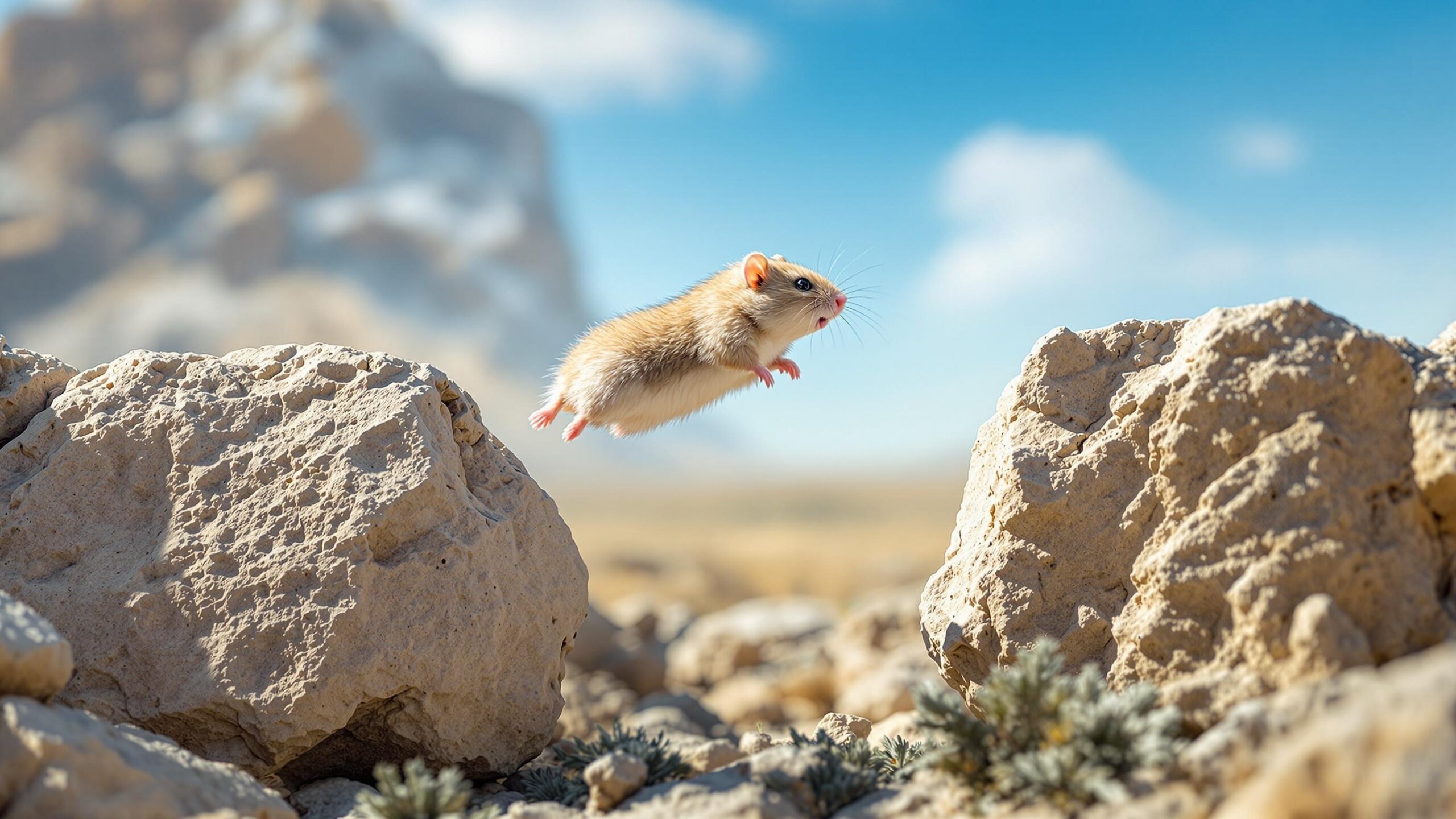The Chinese Hamster: A Tiny Acrobat with a Big Personality
Meet the Chinese Hamster (Cricetulus griseus), a small, agile rodent that might be modest in size but is rich in charm, character, and scientific interest. Often overshadowed by its more famous hamster cousins like the Syrian and the Roborovski, the Chinese Hamster is a fascinating species in its own right. With its silky fur, distinctive tail, and quick, inquisitive nature, this little mammal has earned admiration from pet owners and researchers alike. Native to the rocky deserts and steppes of northern China and Mongolia, the Chinese Hamster is a master of adaptation, surviving in harsh environments and displaying remarkable behaviors that have even made it valuable in the field of medical science.
Though not as widely kept as other domestic hamsters, the Chinese Hamster has a quiet fan base that appreciates its intelligence and agility. Let’s explore this small wonder in detail—its natural history, physical traits, behavior, habitat, scientific importance, and the growing interest in its conservation.
Origins in the Dusty Heart of Asia
The Chinese Hamster is indigenous to the arid and semi-arid regions of northern China and Mongolia, particularly the provinces of Hebei, Liaoning, Shanxi, and Inner Mongolia. These landscapes are a mix of sparse vegetation, rocky outcrops, dry steppes, and grasslands—challenging environments where only the most adaptable creatures thrive. Chinese Hamsters have evolved to cope with extreme temperature fluctuations, from bitterly cold winters to scorching hot summers.
Unlike some of the burrowing rodents that dig extensive tunnel systems, Chinese Hamsters often use preexisting crevices or the abandoned burrows of other animals to create their homes. In the wild, they’re nocturnal and solitary, emerging at dusk to forage for seeds, grains, roots, and the occasional insect. Their diet reflects their environment: hardy, drought-resistant foods that provide the nutrients necessary for survival in a tough climate.
A Profile in Miniature: Physical Characteristics
The Chinese Hamster is notably different in appearance from the chunkier Syrian or the rounded Dwarf hamsters. It is long and lean, with a body length ranging from 9 to 12 centimeters, and weighs about 30 to 45 grams. What truly sets it apart is its tail—longer than any other hamster species—typically measuring up to 3 centimeters. This tail provides excellent balance and agility, aiding the Chinese Hamster in climbing and navigating tricky terrain.
Their fur is short, soft, and usually a light brown or grayish-brown color with a dark dorsal stripe running along the back. The belly is typically lighter, often a soft gray or white. Their eyes are black and bead-like, offering keen nighttime vision, and their small rounded ears are sensitive to sound.
There are also domesticated color variations, with some individuals showing white coats or piebald patterns, although these are more common in pet and laboratory populations than in the wild.
Behavior and Temperament: Curious, Fast, and Fierce
Despite their small size, Chinese Hamsters have bold personalities. They are fast movers, capable climbers, and alert creatures that spend much of their waking hours exploring their environment. In captivity, they are known for their acrobatics and love of climbing toys, ropes, and bars. Given the chance, they will scale cage walls, leap across small gaps, and investigate every corner.
Unlike Syrian Hamsters, which are famously solitary and often aggressive toward others of their kind, Chinese Hamsters exhibit a bit more tolerance, especially if introduced at a young age. However, they still have a solitary streak and can be territorial, so housing multiple individuals requires care, space, and close supervision.
Their temperament is typically calm and observant. Though shy at first, with regular handling they can become quite tame and even affectionate toward their human caretakers. They are not particularly prone to biting and are often more patient than their dwarf cousins when being handled.
Life in the Wild: Adaptations and Survival
In their natural range, Chinese Hamsters are prey animals, constantly on alert for threats from birds of prey, snakes, foxes, and even domestic cats and dogs. Their survival depends on stealth, speed, and their excellent camouflage. Their nocturnal habits also help them avoid many daytime predators.
They are hoarders by instinct, frequently transporting food back to their nests using expandable cheek pouches. These cheek pouches can stretch incredibly far, sometimes reaching all the way back to their shoulders. A well-prepared Chinese Hamster will have several storage areas within its nest where food is tucked away for leaner times.
To cope with the region’s brutal winters, they sometimes enter a state of torpor—a kind of light hibernation—where their metabolic rate slows dramatically. This behavior is less common in captivity, but in the wild, it can mean the difference between life and death.
Chinese Hamsters in Science: A Genetic Goldmine
One of the most remarkable contributions of the Chinese Hamster has nothing to do with pet ownership or wild behavior—it lies in medical research. The Chinese Hamster Ovary (CHO) cell line is one of the most important tools in biotechnology. Derived from the ovarian cells of this species, CHO cells are used in laboratories worldwide to produce biologic drugs, including insulin, monoclonal antibodies, and vaccines.
CHO cells are favored for their rapid growth, ability to be genetically manipulated, and their capability to produce proteins that are compatible with human biology. As a result, the Chinese Hamster has become one of the unsung heroes of modern medicine, helping researchers fight diseases ranging from cancer to autoimmune disorders.
Although these cell lines were first developed in the 1950s, they are still widely used today, and ongoing research continues to depend on the stable genetics of this tiny rodent.
In Captivity: The Quiet Appeal of the Chinese Hamster as a Pet
While not as ubiquitous as the Syrian or Roborovski hamsters in the pet trade, Chinese Hamsters make excellent pets for the right kind of owner. Their quieter demeanor and athleticism appeal to people who enjoy watching natural behaviors and don’t mind a nocturnal schedule.
They are best suited to individuals or older children who understand how to handle small animals gently. Due to their size and speed, they are not ideal for very young children or households with many pets. Proper housing includes a secure cage with horizontal bars for climbing, a solid running wheel (not mesh or wire), tunnels, hideouts, and plenty of chewable items to keep their ever-growing teeth in check.
They thrive in a stable, low-stress environment and can live up to 2 to 3 years in captivity with good care. Diet-wise, they do well on a mix of hamster-safe seeds, grains, fresh vegetables, and occasional high-protein treats such as mealworms or boiled egg pieces.

Conservation Status and Environmental Pressures
At present, the Chinese Hamster is not considered endangered and holds a status of “Least Concern” on the IUCN Red List. Its broad distribution across northern China and Mongolia has helped it maintain relatively stable wild populations, and it is not currently facing imminent threats of extinction.
However, this doesn’t mean the species is immune to environmental pressures. Habitat degradation due to agricultural expansion, climate change, and infrastructure development does pose a growing risk, particularly in regions where grasslands are converted into croplands or urban spaces.
Moreover, the genetic bottleneck effect from domesticated breeding—both for pets and scientific use—means that the Chinese Hamsters in captivity may not be representative of their wild counterparts. Efforts to preserve genetic diversity are becoming more important as their scientific use expands.
Though conservation efforts for the species aren’t high-profile, they would benefit from broader protections of grassland ecosystems in Asia, which support a rich tapestry of biodiversity.
Differences from Other Hamsters: What Makes Them Unique?
The Chinese Hamster is often confused with dwarf hamsters due to its small size, but it does not belong to the same genus as true dwarfs like the Campbell’s or the Winter White. Belonging to the genus Cricetulus, it is more closely related to the gray dwarf hamsters of Asia. It has a notably longer body and tail, with a sleeker and more agile frame.
Behaviorally, it is a bit of a hybrid. It shares the solitary nature of Syrian Hamsters but can, in rare cases, be cohabited like dwarf hamsters if raised together from a young age. Its climbing skills and tail balance give it an edge in environments that require vertical movement—something not seen in many other hamster species.
Its use in laboratory science also sets it apart. While other rodents like mice and rats are common lab animals, few species have had as wide-reaching an impact in biotechnology as the Chinese Hamster.
Breeding and Reproduction
Breeding Chinese Hamsters, whether in captivity or under research conditions, follows many of the same biological principles seen in other rodents. Females reach sexual maturity by about six to eight weeks of age and have a gestation period of around 18 to 21 days. Litters typically contain 4 to 6 pups, although larger ones are not uncommon.
Newborns are hairless, blind, and utterly dependent on their mothers. Within two weeks, they begin to open their eyes and explore their surroundings, and by three to four weeks of age, they are usually weaned and ready for independence.
In the wild, Chinese Hamsters breed seasonally—usually from spring through early autumn—but in captivity, they may breed year-round. Due to their strong maternal instincts and rapid reproductive cycle, their populations can grow quickly under the right conditions.
Human Interaction and Ethical Considerations
As with all animals used in science and as pets, the Chinese Hamster presents a case for responsible treatment. In research, ethical guidelines require that these animals be housed humanely, used only when necessary, and provided with proper enrichment and veterinary care. The scientific value they provide is immense, but it must be balanced with ethical accountability.
In the pet world, breeders and sellers have a responsibility to prioritize health and genetics. Overbreeding or irresponsible handling can lead to temperament issues, health problems, or stress in these sensitive creatures. For would-be owners, the key is education: understanding the animal’s needs, behaviors, and natural rhythms.
The Quiet Importance of a Small Mammal
The Chinese Hamster may never achieve the stardom of its flashier cousins, but in many ways, it represents the best of what small mammals can offer. It is a survivor in harsh wildlands, a gentle companion in the home, and a quiet but powerful contributor to scientific breakthroughs that affect millions of human lives.
Its story is a reminder that size does not determine significance. Whether scurrying across the steppe or growing cells in a lab dish, the Chinese Hamster continues to shape the world in small but meaningful ways. It is a species worth knowing, appreciating, and, yes, protecting—not just for its utility, but for its quiet brilliance in the tapestry of life.

